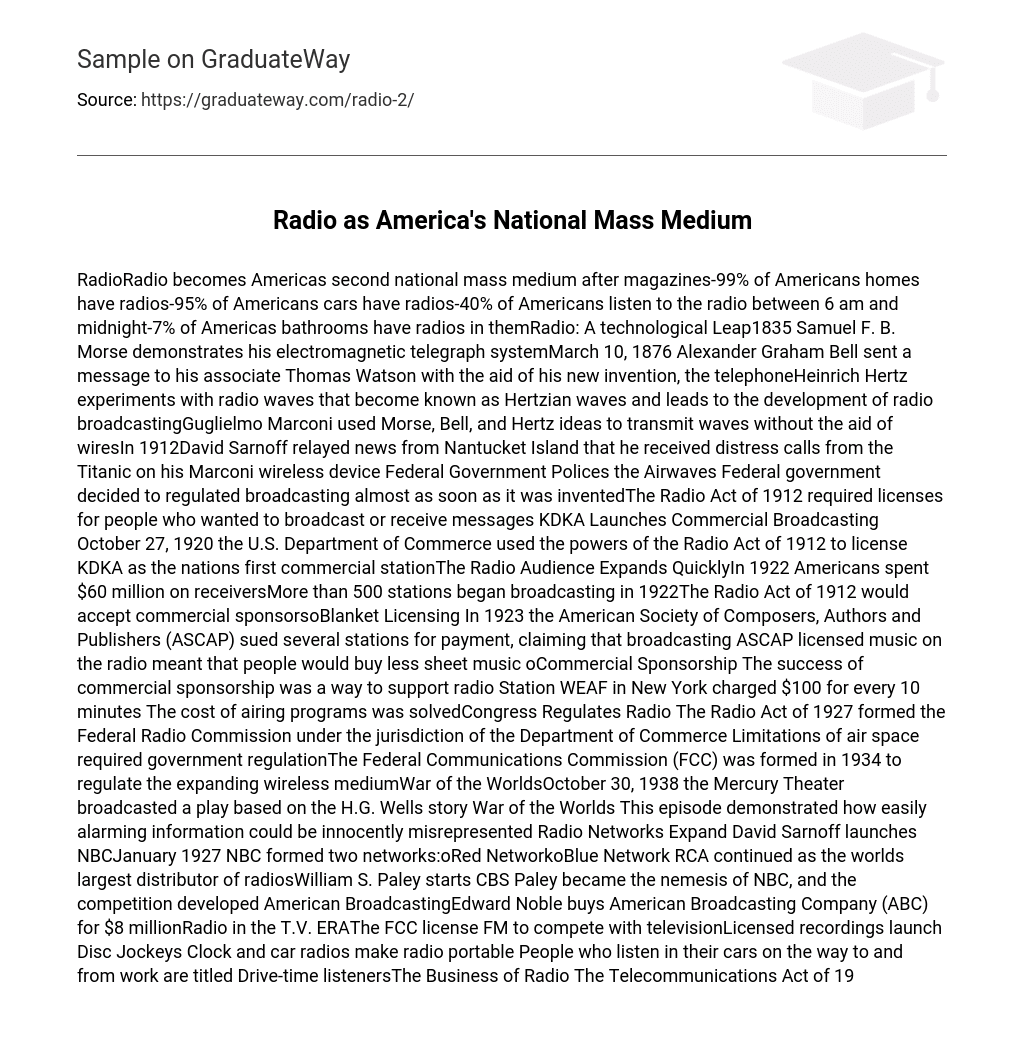RadioRadio becomes Americas second national mass medium after magazines-99% of Americans homes have radios-95% of Americans cars have radios-40% of Americans listen to the radio between 6 am and midnight-7% of Americas bathrooms have radios in themRadio: A technological Leap1835 Samuel F. B. Morse demonstrates his electromagnetic telegraph systemMarch 10, 1876 Alexander Graham Bell sent a message to his associate Thomas Watson with the aid of his new invention, the telephoneHeinrich Hertz experiments with radio waves that become known as Hertzian waves and leads to the development of radio broadcastingGuglielmo Marconi used Morse, Bell, and Hertz ideas to transmit waves without the aid of wiresIn 1912David Sarnoff relayed news from Nantucket Island that he received distress calls from the Titanic on his Marconi wireless device Federal Government Polices the Airwaves Federal government decided to regulated broadcasting almost as soon as it was inventedThe Radio Act of 1912 required licenses for people who wanted to broadcast or receive messages KDKA Launches Commercial Broadcasting October 27, 1920 the U.S. Department of Commerce used the powers of the Radio Act of 1912 to license KDKA as the nations first commercial stationThe Radio Audience Expands QuicklyIn 1922 Americans spent $60 million on receiversMore than 500 stations began broadcasting in 1922The Radio Act of 1912 would accept commercial sponsorsoBlanket Licensing In 1923 the American Society of Composers, Authors and Publishers (ASCAP) sued several stations for payment, claiming that broadcasting ASCAP licensed music on the radio meant that people would buy less sheet music oCommercial Sponsorship The success of commercial sponsorship was a way to support radio Station WEAF in New York charged $100 for every 10 minutes The cost of airing programs was solvedCongress Regulates Radio The Radio Act of 1927 formed the Federal Radio Commission under the jurisdiction of the Department of Commerce Limitations of air space required government regulationThe Federal Communications Commission (FCC) was formed in 1934 to regulate the expanding wireless mediumWar of the WorldsOctober 30, 1938 the Mercury Theater broadcasted a play based on the H.G. Wells story War of the Worlds This episode demonstrated how easily alarming information could be innocently misrepresented Radio Networks Expand David Sarnoff launches NBCJanuary 1927 NBC formed two networks:oRed NetworkoBlue Network RCA continued as the worlds largest distributor of radiosWilliam S.
Paley starts CBS Paley became the nemesis of NBC, and the competition developed American BroadcastingEdward Noble buys American Broadcasting Company (ABC) for $8 millionRadio in the T.V. ERAThe FCC license FM to compete with televisionLicensed recordings launch Disc Jockeys Clock and car radios make radio portable People who listen in their cars on the way to and from work are titled Drive-time listenersThe Business of Radio The Telecommunications Act of 1996 Overhauls Radio This act removes the limit on the number of radio stations a company can ownCross-ownership allows companies to own radio and television stations in the same marketRadio depends on ready-made formatsTechnology and the Future Identifying a specific audience segment and programming is called narrow castingDemand programming is a term that describes radio future possibilitiesNew Digital Audio broadcasting can send music and information in the form of zeroes and ones as in a computer code





